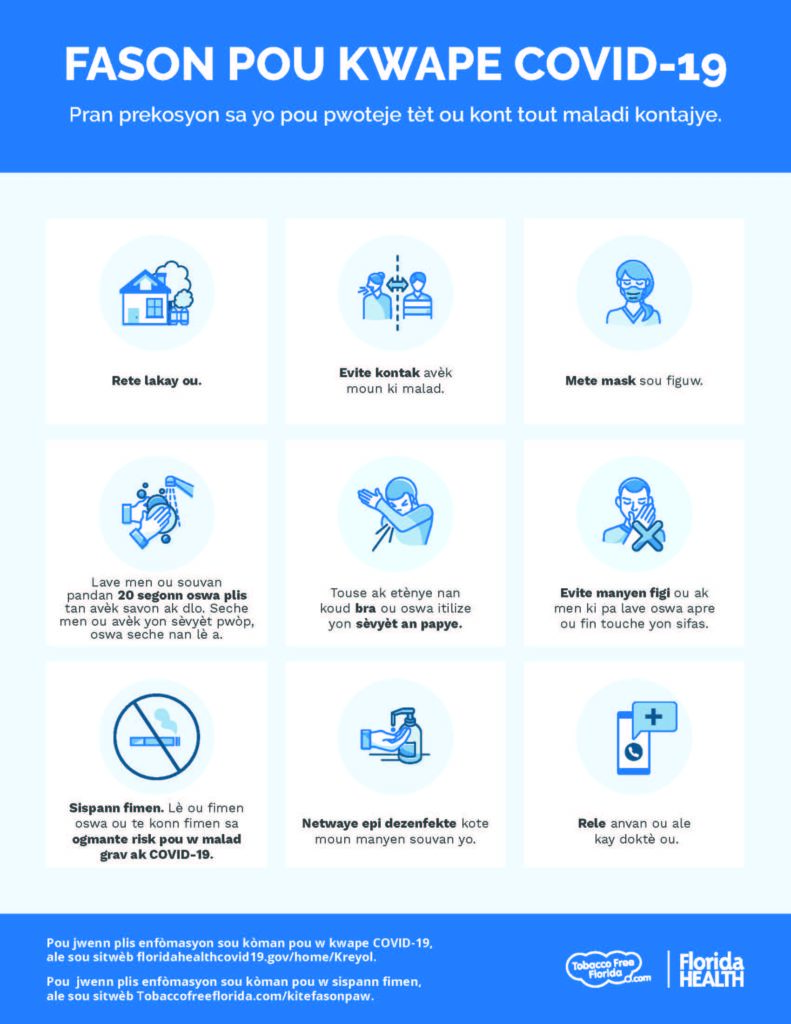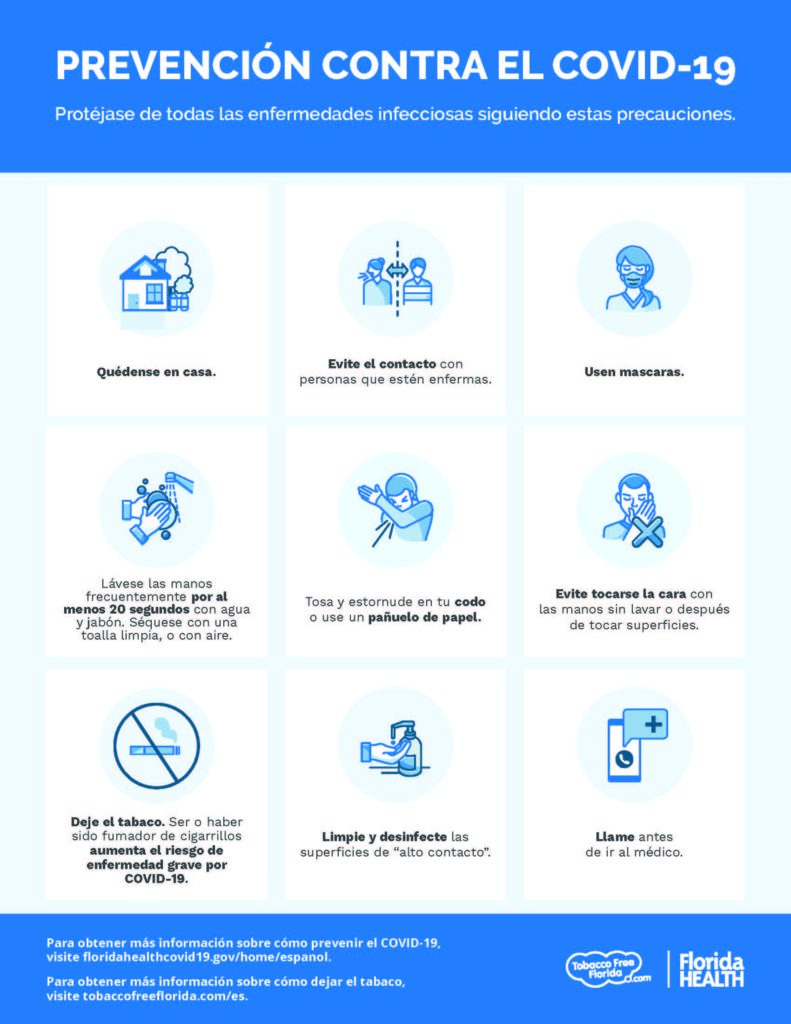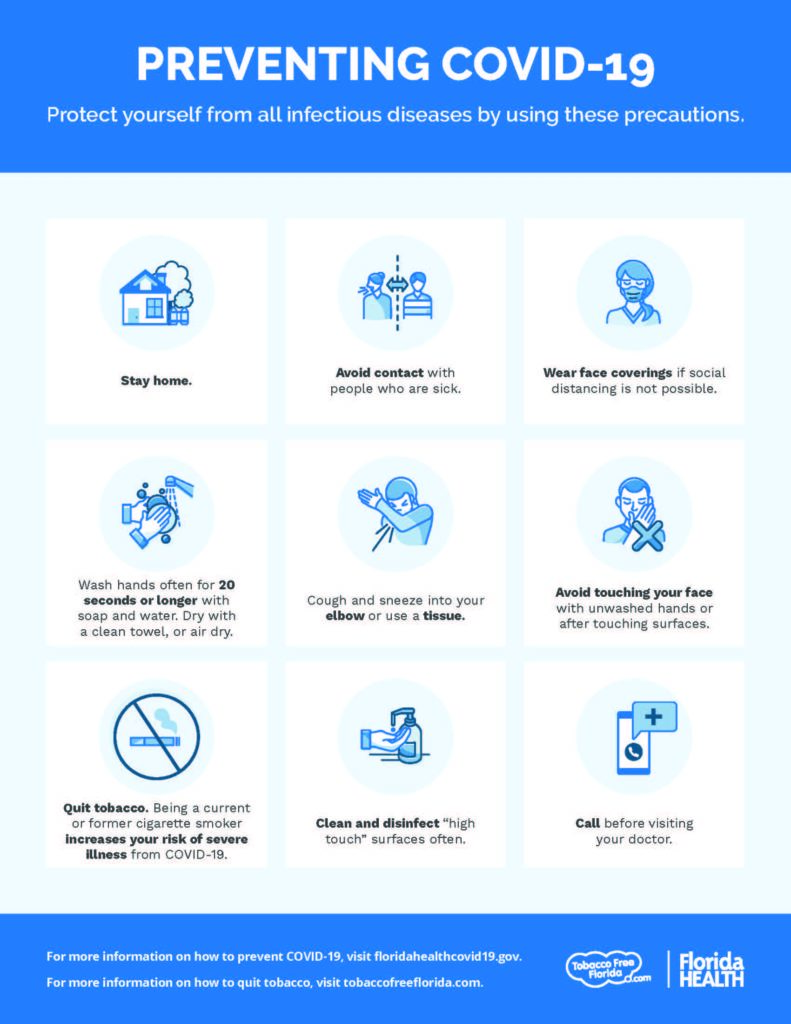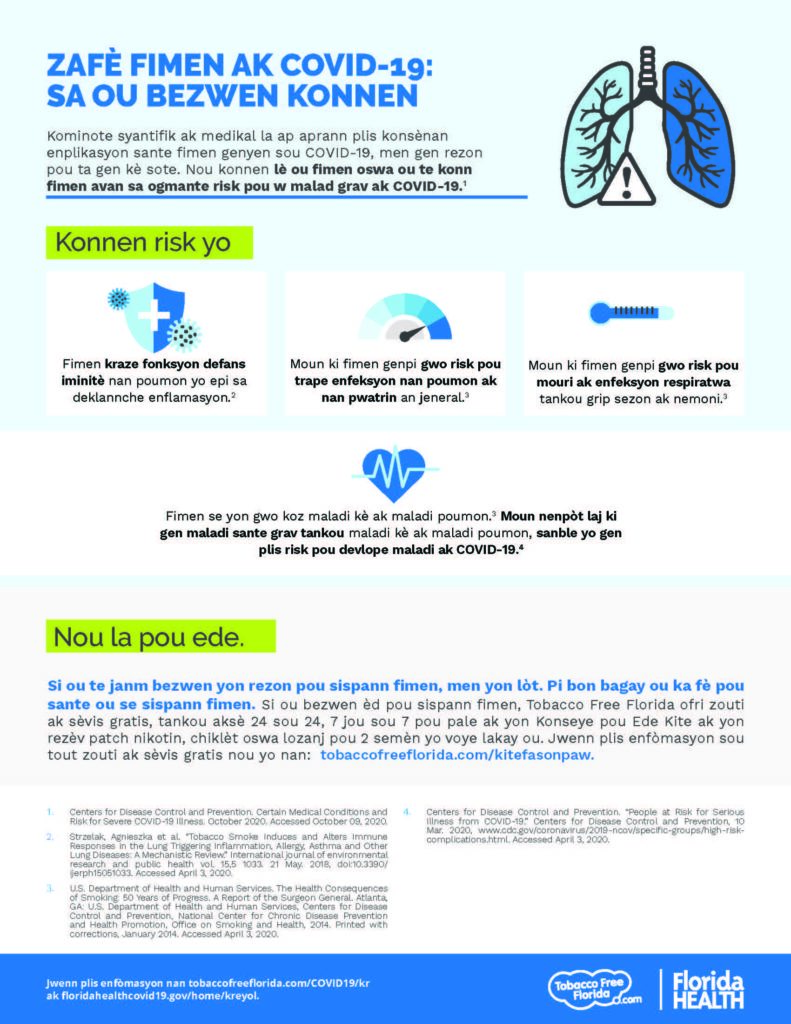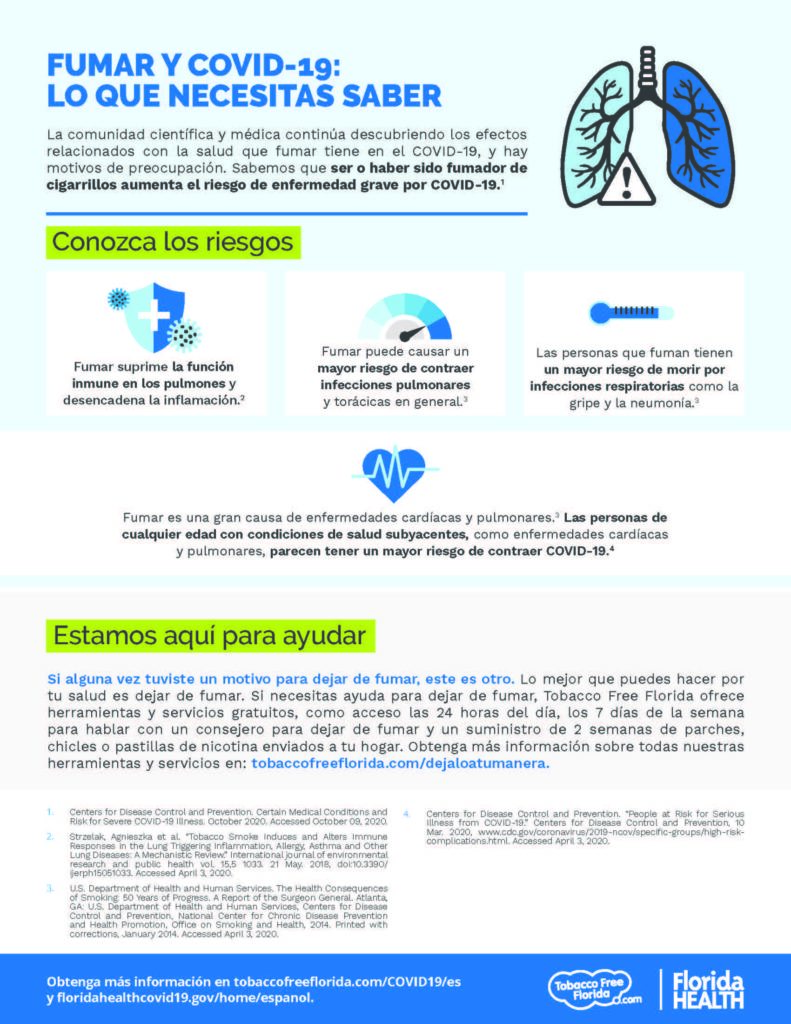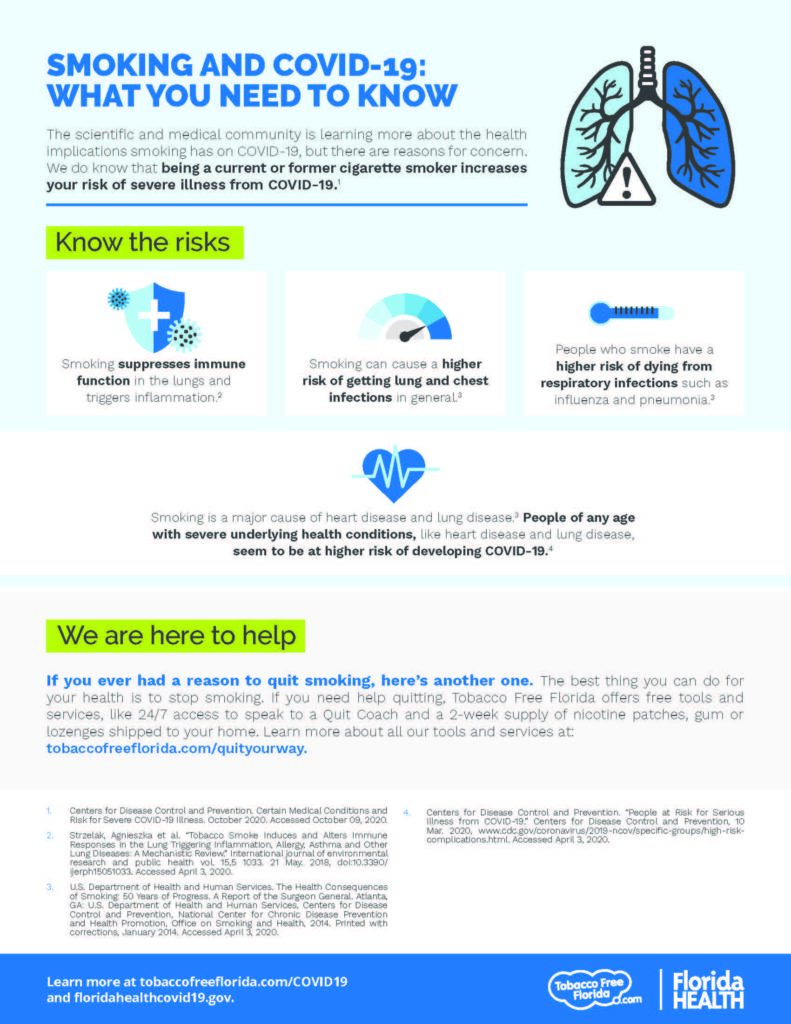Campus de colleges libres de humo y de tabaco
Los colleges de Florida se están liberando del tabaco para convertirse en lugares más saludables donde aprender y prepararse para el éxito. Un campus libre de tabaco reduce la exposición al tabaco de segunda mano, previene la iniciación en el consumo de tabaco y motiva a los fumadores para que dejen de fumar. 1, 2, 3
¿Por qué estar libre de tabaco?
Las políticas para estar libres de tabaco en colleges y universidades protegen a los estudiantes, a los profesores y a los empleados del humo de segunda mano, el cual contiene más de 7,000 sustancias químicas y aumenta el riesgo de cáncer, enfermedades cardíacas y derrames cerebrales entre los no fumadores. 4, 5, 6 Los adultos jóvenes que fuman a menudo sufren adicción al tabaco de por vida, lo que resulta en enfermedades relacionadas con el tabaco y en muerte prematura. 7 En Estados Unidos, todos los días más de 2,500 jóvenes y adultos jóvenes que fuman ocasionalmente se convertirán en fumadores habituales. 8
La adopción de políticas libres de humo también beneficia al medio ambiente. Solo 1 de 10 cigarrillos que se fuman se desecha de manera apropiada. 9 De hecho, las colillas de cigarrillos son el artículo que más se desecha indebidamente en el mundo y acumula 1,690 millones de libras de basura tóxica todos los años. 10 Al mismo tiempo, un estudio demostró que los predios universitarios con políticas 100% libres de humo tenían 77% menos colillas de cigarrillos. 11
En la actualidad, la mayoría de los campus son libres de humo. Al menos 2,375 colleges y universidades en EE.UU. han adoptado políticas 100% libres de humo, de las cuales 2,009 son libres de tabaco, 1,986 prohíben el uso de cigarrillos electrónicos y 1,019 prohíben el uso de hookahs. 12 Tener una política libre de tabaco puede resultar en una ventaja de marketing y aumentar el número de matrículas, ya que la mayoría de los estudiantes prefieren instituciones libres de tabaco. 13 Una encuesta realizada por la Asociación de Gobierno Estudiantil de Florida State University halló que el 75.6% de los estudiantes apoyan la implementación de una política libre de tabaco en el campus. 14
Tipos de políticas
Las políticas 100% libres de humo prohíben el uso de cigarrillos convencionales en la propiedad, los estacionamientos, los eventos fuera del campus patrocinados por el college y los vehículos de propiedad del college. Las políticas libres de tabaco son similares, pero prohíben el uso de todo tipo de productos de tabaco. Las políticas habitualmente se aplican a estudiantes, profesores, empleados y visitantes. Es importante que estas políticas incluyan productos de tabaco emergentes, como los cigarrillos electrónicos. El uso de los cigarrillos electrónicos por los jóvenes es una epidemia nacional. Además, el consumo de estos productos puede crear confusión en cuanto a las políticas y permitir que los fumadores usen nicotina en lugares donde se prohíbe fumar. 15
Protección y defensa
En Florida, 41 colleges y universidades han tomado la valiente medida de declarar políticas 100% libres de humo en sus campus. Para ver una lista completa, haz clic aqui. Si necesitas ayuda para hacer que tu comunidad adopte una política libre de humo, haz clic aquí.
1 U.S. Department of Health and Human Services. The Health Consequences of Smoking: 50 Years of Progress. A Report of the Surgeon General. Atlanta, GA: U.S. Department of Health and Human Services, Centers for Disease Control and Prevention, National Center for Chronic Disease Prevention and Health Promotion, Office on Smoking and Health, 2014.
2 U.S. Department of Health and Human Services. Preventing Tobacco Use Among Youth and Young Adults: A Report of the Surgeon General. Atlanta, GA: U.S. Department of Health and Human Services, Centers for Disease Control and Prevention, National Center for Chronic Disease Prevention and Health Promotion, Office on Smoking and Health, 2012.
3 William V. Lechner MS , Ellen Meier MS , Mary Beth Miller MS , Josh L. Wiener PhD & Yvon Fils-Aime MD (2012): Changes in Smoking Prevalence, Attitudes, and Beliefs Over 4 Years Following a Campus-Wide Anti-tobacco Intervention, Journal of American College Health, 60:7, 505-511.
4 Centers for Disease Control and Prevention (US); National Center for Chronic Disease Prevention and Health Promotion (US); Office on Smoking and Health (US). How Tobacco Smoke Causes Disease: The Biology and Behavioral Basis for Smoking-Attributable Disease: A Report of the Surgeon General. Atlanta (GA): Centers for Disease Control and Prevention (US); 2010.
5 U.S. Department of Health and Human Services. Let’s Make the Next Generation Tobacco-Free: Your Guide to the 50th Anniversary Surgeon General’s Report on Smoking and Healthpdf iconexternal icon. [PDF–795 KB] Atlanta: U.S. Department of Health and Human Services, Centers for Disease Control and Prevention, National Center for Chronic Disease Prevention and Health Promotion, Office on Smoking and Health, 2014.
6 U.S. Department of Health and Human Services. The Health Consequences of Smoking—50 Years of Progress: A Report of the Surgeon General. Atlanta: U.S. Department of Health and Human Services, Centers for Disease Control and Prevention, National Center for Chronic Disease Prevention and Health Promotion, Office on Smoking and Health, 2014.
7 U.S. Department of Health and Human Services. Preventing Tobacco Use Among Youth and Young Adults: A Report of the Surgeon General. Atlanta, GA: U.S. Department of Health and Human Services, Centers for Disease Control and Prevention, National Center for Chronic Disease Prevention and Health Promotion, Office on Smoking and Health, 2012.
8 U.S. Department of Health and Human Services. Preventing Tobacco Use Among Youth andYoung Adults: A Report of the Surgeon General. Atlanta, GA: U.S. Department of Health and Human Services, Centers for Disease Control and Prevention, National Center for Chronic Disease Prevention and Health Promotion, Office on Smoking and Health, 2012.
9 iQ Research & Consulting. Keep America Beautiful Pocket Ashtray Study, January 2008 – See more at: https://tobaccofreeflorida.com/current-issues/tobacco-free-beaches-and-parks-the-issue/#sthash.hbpvmNQw.dpuf.
10 Novotny, Thomas E., Kristen Lum, Elizabeth Smith, Vivian Wang, and Richard20 Barnes. “Cigarettes Butts and the Case for an Environmental Policy on Hazardous Cigarette Waste.” International Journal of Environmental Research and Public Health. Molecular Diversity Preservation International (MDPI), 20 May 2009. Web. 27 July 2015. <https://www.ncbi.nlm.nih.gov/pmc/articles/PMC2697937/>.
11 Seo, D. C., Macy, J. T., Torabi, M. R., & Middlestadt, S. E. (2011). The effect of a smoke-free campus policy on college students’ smoking behaviors and attitudes. Preventive medicine, 53(4), 347-352.
12 American Nonsmokers’ Rights Foundation. “Smokefree and Tobacco-Free U.S. and Tribal Colleges and Universities.” 1 Jul 2019. https://no-smoke.org/pdf/smokefreecollegesuniversities.pdf.
13 Smoke Free Oregon. “Making Your College Campus Tobacco free.” Parenting Handout (2005): n. pag. Web. 16 July 2015. <https://tobaccofreecampus.org/sites/default/files/resources/Oregon%20Guide.pdf>.
14 Baig, Setareh. “Students Debate Smoke-free Campus.” Tallahassee Democrat. N.p., 24 Apr. 2013. Web. 20 Aug. 2015.
15 Americans for Nonsmokers’ Rights (ANR). Model Ordinance Prohibiting Smoking in All Workplaces and Public Places (100% Smokefree). https://no-smoke.org/pdf/modelordinance.pdf.



